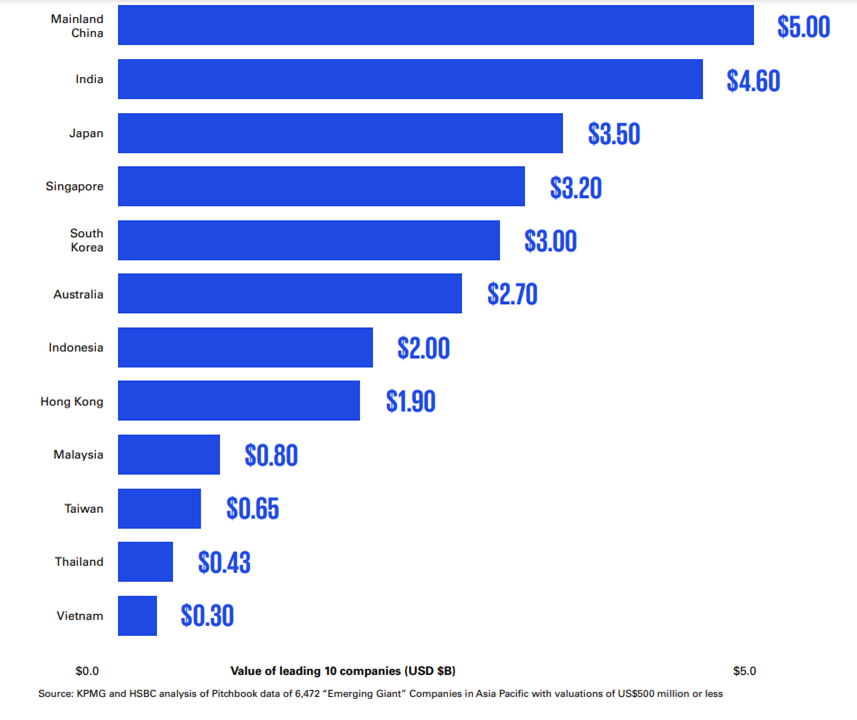In the APAC region, Unified Communications as a Service (UCaaS) technology has facilitated a massive shift towards digital transformation in the communication space.
In 2022, the spend on cloud infrastructure in the Asia Pacific region reached US$8.7 billion in the second quarter. This figure represented an increase of 35% and constituted 14% of the worldwide spend on cloud services.

Asia Pacific’s leading large enterprises are driving economic growth, by taking advantage of ambitious, cutting-edge new platforms and software technologies.
These organizations are re-shaping their business models and objectives, and transforming company culture by thinking about what is beneficial to their customers today. In the coming years, it’s predicted that they will transform the technology landscape throughout the APAC region in almost every industry.
The combined value of APAC’s leading companies in each of the twelve markets: Figures in $US billion
 Source: KPMG
Source: KPMG
The mass adoption of remote working
In every sector, remote and hybrid working models are being implemented globally with great success, a strategy that wouldn’t be possible without cloud-based infrastructure.
While initially, the adoption of cloud migration in the APAC region was slower compared to the western world, today the Asia Pacific sector is rapidly increasing its investment in UCaaS.
In fact, a report by Mordor Intelligence revealed that the ASEAN Unified Communication-as-a-Service Market is expected to register a CAGR of 12.27% over the forecast period from 2021 to 2026.
Organizations in the APAC region, from large enterprises to SMBs are now heavily relying on web conferencing, video calling and instant messaging platforms to efficiently and effectively communicate in the workplace. During COVID, major cities including Beijing, Shanghai and Guangzhou were forced to adopt remote working models, resulting in a surge in demand for video-conferencing and communication apps.
This has led to the widespread shift to cloud computing, allowing dispersed teams and contact centers to leverage a unified working platform. And for a majority of businesses in the ASEAN, this new away-from-the-office working culture, while taking time to get used to, is here to stay.
UCaaS creating business growth
Organizations have realized that UCaaS technology can create increased efficiency and productivity, faster communication, easier collaboration, and more flexible working arrangements.
"In APAC, organisations across telecommunications, government and defence, financial services and manufacturing, as well as sovereign cloud providers have been the most receptive to adopting cloud networking", Vish Iyer, VP for architectures at Cisco Asia-Pacific, Japan and China.
By utilizing cloud technology and UCaaS applications, companies can save money, raise efficiency and future-proof their businesses. With faster connection speeds, easier access to software upgrades and the ability to connect to a network from any device and multiple locations, they can not only achieve business continuity, but become more competitive.
The challenges of UCaaS adoption
Even businesses with minimum IT budgets are adopting cost-effective cloud-based solutions, with the aim of enhancing customer service assistance throughout customer service centers.
But adopting the technology that enables this newer, more efficient way of working doesn’t come without challenges.
Geopolitical conflict, global economic pressures, and the desire to improve the lives of consumers and citizens is seeing APAC prioritizing technology investments in 2023. But many companies will struggle to keep pace with rising customer expectations around omnichannel experiences as well environmental, social, and governance (ESG) commitments.
Additionally, with any introduction of new technology, it’s crucial that solutions are in place to monitor systems, performance, and results, as well as providing analytics to manage huge volumes of data.
Proactive monitoring of UCaaS infrastructures is vital to success
With the adoption of cloud-based services increasing rapidly, businesses are realizing there is a rising need for an effective, easily maintained network monitoring and troubleshooting system. This is particularly important, considering the huge number of older, legacy contact centers and UC infrastructures throughout the region. In order for cloud-based apps to deliver on the promise of improved productivity and collaboration, there are recurring issues that every organization needs to address.
- With widely dispersed networks, there are bound to be connectivity issues. No business wants to suffer downtime because of dropped calls, bad video connections or sub-par audio
- Employee experience is vital. Businesses need to know that their teams are comfortable navigating new software and systems
- End-to-end visibility of an entire UC ecosystem means companies can immediately pinpoint and rectify problems, whether they’re occurring within a specific network, device, or location
It’s now more important than ever that organizations have the right tools in place to support new cloud-based infrastructures.
How IR Collaborate can help
There are multiple infrastructure platforms within a cloud-based UC system, including different vendor systems and applications, additional devices, and users. This increases the possibility of incompatibility of tools and processes. Data security becomes an issue, as does the impact on user experience.
- IR’s Collaborate suite of solutions provides the intelligent insights that any business needs by allowing deep insights into your data so that you can understand performance
- Collaborate can proactively help prevent problems by creating alerts
- Our solutions can test voice, video, web, and collaboration ecosystems
- Collaborate provides end-to-end, multi-vendor visibility from a single pane of glass



